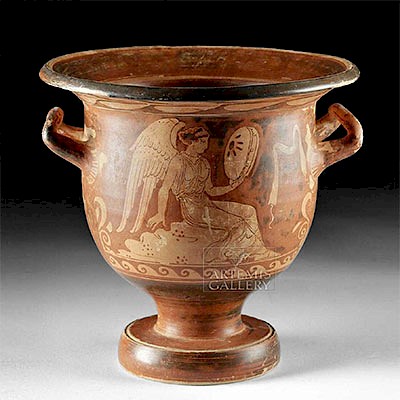Romano-Egyptian Terracotta Votive - Phallic Harpocrates
Lot 15a
About Seller
Artemis Fine Arts
686 S Taylor Ave, Ste 106
Louisville, CO 80027
United States
Selling antiquities, ancient and ethnographic art online since 1993, Artemis Gallery specializes in Classical Antiquities (Egyptian, Greek, Roman, Near Eastern), Asian, Pre-Columbian, African / Tribal / Oceanographic art. Our extensive inventory includes pottery, stone, metal, wood, glass and textil...Read more
Estimate:
$1,200 - $1,700
Absentee vs Live bid
Two ways to bid:
- Leave a max absentee bid and the platform will bid on your behalf up to your maximum bid during the live auction.
- Bid live during the auction and your bids will be submitted real-time to the auctioneer.
Bid Increments
| Price | Bid Increment |
|---|---|
| $0 | $25 |
| $300 | $50 |
| $1,000 | $100 |
| $2,000 | $250 |
| $5,000 | $500 |
| $10,000 | $1,000 |
| $20,000 | $2,500 |
| $50,000 | $5,000 |
| $100,000 | $10,000 |
| $200,000 | $20,000 |
About Auction
By Artemis Fine Arts
Mar 7, 2019
Set Reminder
2019-03-07 10:00:00
2019-03-07 10:00:00
America/New_York
Bidsquare
Bidsquare : VARIETY SALE | Antiquities & Ethnographic Art
https://www.bidsquare.com/auctions/artemis-gallery/variety-sale-antiquities-ethnographic-art-3928
Around the world & back in time - be amazed at the treasures you will find. Antiquities from Egypt, Greece, Italy and the Near East, Asian, Pre-Columbian, African / Tribal / Oceanic, Native American, Spanish Colonial, Russian Icons, Fine Art, much more! Artemis Fine Arts info@artemisgallery.com
Around the world & back in time - be amazed at the treasures you will find. Antiquities from Egypt, Greece, Italy and the Near East, Asian, Pre-Columbian, African / Tribal / Oceanic, Native American, Spanish Colonial, Russian Icons, Fine Art, much more! Artemis Fine Arts info@artemisgallery.com
- Lot Description
Egypt, Romano-Egyptian period, ca. 1st century BCE to 1st century CE. A mold-made terracotta votive figure of the god Harpocrates (Harpokrates), depicted here with a massive phallus resting on his thighs and another resting against his lap rising to his shoulder. The figure is made of a thick, red clay, and was once brightly painted - some of the pigment remains, notably pale pink and white. Size: 3.7" L x 2.7" W x 7.25" H (9.4 cm x 6.9 cm x 18.4 cm)
During the Ptolemaic period, Isis-Hathor, Serapis, and Harpocrates formed the Triad of Alexandria, gods worshipped in the region who had a complementary relationship. The British Museum exhibit on Naukratis showed the remains of terracotta molds for making models just like this one; they were made from a dark red-brown Nile silt in vast workshops. These figures were made for locals, but reflected the influence of Greek naturalistic styles in their depictions of the deities. They were bought by individuals and are found overwhelmingly in domestic contexts. Harpocrates was the god of silence, secrets, and confidentiality. The phallus symbol was seen in the Roman period as a good luck charm, specifically for bringing fortune.
Provenance: private New York, New York, USA collection; purportedly deaccessioned from Museum of World Treasures, Wichita, Kansas, USA
All items legal to buy/sell under U.S. Statute covering cultural patrimony Code 2600, CHAPTER 14, and are guaranteed to be as described or your money back.
A Certificate of Authenticity will accompany all winning bids.
We ship worldwide and handle all shipping in-house for your convenience.
#143590Losses from top of head and base. Wear on surface commensurate with age. Nice remains of pigment on surface. Old collection stickers on underside.Condition
- Shipping Info
-
All shipping is handled in-house for your convenience. Your invoice from Artemis Gallery will include shipping calculation instructions. If in doubt, please inquire BEFORE bidding for estimated shipping costs for individual items.
-
- Buyer's Premium



 EUR
EUR CAD
CAD AUD
AUD GBP
GBP MXN
MXN HKD
HKD CNY
CNY MYR
MYR SEK
SEK SGD
SGD CHF
CHF THB
THB
















